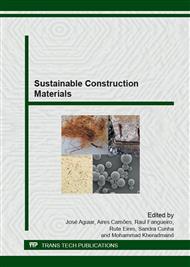p.85
p.97
p.113
p.121
p.131
p.139
p.151
p.163
p.172
Evaluating the Pozzolanic Activity of Spent Catalyst Partially Substituting Type II Portland Cement
Abstract:
The catalyst discarded from fluidized catalytic cracking (FCC) units of heavy oil fractions presents in its composition typically high concentrations of silica and alumina, which give to it the possibility to be used as a pozzolanic material. The pozzolanic activity of a spent FCC catalyst from a Brazilian refinery oil was evaluated by studying the influence of the substitution in different degrees of a type II cement, by this catalytic residue on the hydration process and on the compressive strength of the formed materials. The influence of different particle size fractions of the residue and of its milling process was studied as well. The pozzolanic activity was evaluated by thermogravimetry (TG), derivative thermogravimetry (DTG) and non-conventional differential-thermal analysis (NCDTA). The results show that the chemical pozzolanic activity is enhanced when the sample presents a higher specific surface, as well as, the milling of the residue it is fundamental in order to be accepted and used as a pozzolanic material on partial substitution to cement.
Info:
Periodical:
Pages:
131-138
Citation:
Online since:
December 2014
Authors:
Keywords:
Price:
Сopyright:
© 2015 Trans Tech Publications Ltd. All Rights Reserved
Share:
Citation:


